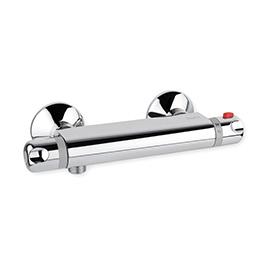HSE >> http://www.hse.gov.uk/pubns/hsis6.pdf

This guidance aims to help health and social care providers comply with their legal duties.
Hot waterIf hot water used for showering or bathing is above 44 °C there is increased risk of serious injury or fatality. Where large areas of the body are exposed to high temperatures, scalds can be very serious and have led to fatalities.
Hot waterEngineering controls should be provided to ensure that water hotter than 44 °C is not discharged from outlets that may be accessible to vulnerable people and where there is the potential for whole-body immersion. Similar controls may be needed at other outlets where people are especially vulnerable (eg basins where people have skin sensitivity impairment).Engineering controls can include:thermostatic mixing valves (TMVs);■■temperature-restricted, instant water heaters.■■TMVs should be located as close as possible to the outlet, where they are necessary. In healthcare settings, Type 3 is the standard required by the Department of Health’s Health Technical Memorandum 04-01 The control of legionella, hygiene, ‘safe’ hot water, cold water and drinking water systems.1 Type 3 TMVs should be installed when TMVs are replaced or where there are new installations. Further information on TMVs can be obtained from the Thermostatic Mixing Valve Association (TMVA) or at http://www.beama.org.uk.TMVs should ensure only safe water temperatures are available. Healthcare standard controls (eg Type 3 TMV or healthcare standard electric showers) and regular safety testing should ensure that the equipment remains safe at all times.Where TMVs are not fitted to baths or showers other equally effective controls should be in place. Locking bathroom doors or removing the hot tap head is not advisable where this will prevent water being flushed out regularly to control the risk from legionella. These measures may only be acceptable in the short term until thermostatic controls are fitted. Where electric showers are fitted, these should be designed so that water cannot be delivered at a temperature that may cause scalding. Domestic electric showers are likely to have temperature regulation features but water temperatures above 44 °C may still occur if there are fluctuations in flow or pressure. If this is the case, and vulnerable people are at risk, additional measures will be required. This may include installing ‘healthcare standard’ showers which are designed to prevent unsafe hot water temperatures under all conditions. NHS standards require these to be fitted in healthcare settings.
What should I do?You should assess potential scalding and burning risks in the context of the vulnerability of those being cared for.A risk assessment of the premises should be carried out to identify what controls are necessary and how the systems will be managed and maintained.The results of the general risk assessment should be taken into account when completing an individual’s care assessment. An individual’s assessment needs to consider whether:the person is likely to try to run a bath or shower ■■or add water when unattended. This is a particular issue for people whose mental capacity is impaired;the person’s lack of mobility means they are unable ■■to respond safely to hot water or surfaces (eg safely get in/out of the bath or shower, or move away from a radiator);the person’s sensitivity to temperature is impaired;■■the person’s mental state means they cannot ■■recognise or react to hot water or a surface that is too hot; the person can summon assistance;■■any lifting or other aids limit mobility in the bath or ■■elsewhere; any furniture, fixtures and fittings restrict movement ■■away from the source of heat.